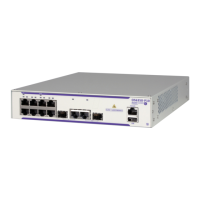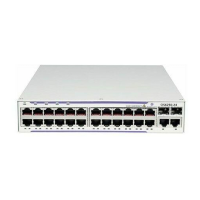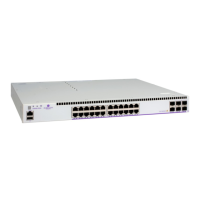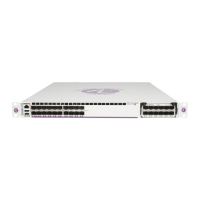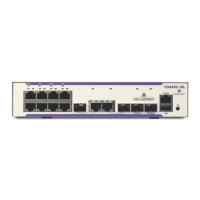Configuring VLANs Assigning Ports to VLANs
OmniSwitch AOS Release 8 Network Configuration Guide December 2017 page 4-7
Using 802.1Q Tagging
Another method for assigning ports to VLANs involves configuring a switch port or link aggregate to
process 802.1Q-tagged frames that contain a specific VLAN ID designation. This method, referred to as
802.1Q tagging (or trunking), allows a single network link to carry traffic for multiple VLANs.
The OmniSwitch implements the IEEE 802.1Q standard for sending frames through the network tagged
with VLAN identification. This section details procedures for configuring and monitoring 802.1Q tagging
on a single switch port or link aggregate group.
“Tagged” refers to four bytes of reserved space in the header of the packet. The four bytes of “tagging” are
broken down as follows: the first two bytes indicate whether the packet is an 802.1Q packet, and the next
two bytes carry the VLAN identification (VID) and priority.
When packets ingress the switch, they are classified into a VLAN based on their 802.1Q tag information.
• If the packet contains an 802.1Q tag, the VLAN ID in the tag must match either the default VLAN ID
for the port or a VLAN ID for which the port is tagged. If there is no match, the packet is dropped.
• If the packet is not tagged at all, the packet is placed into the default VLAN to which the port that
received the packet is assigned.
The following diagram illustrates a simple network by using tagged and untagged traffic:
Tagged and Untagged Traffic Network
Switch 1 and 2 have three VLANs, one for untagged traffic and two for tagged traffic. The ports
connecting Switch 1 and 2 are configured in such a manner that the ports accept both tagged traffic for
VLANS 2 and 3 and untagged traffic for VLAN 1.
A port can only be assigned to one untagged VLAN (in every case, this is the default VLAN
configuration). In this example the default VLAN for port 2/1 and port 4/3 is VLAN 1. The port can be
assigned to as many 802.1Q-tagged VLANs as necessary.
Configuring 802.1Q Tagging
To set a port to be a tagged port, use the vlan members tagged command and specify a VLAN
identification (VID) number and a port number. For example, to configure port 3/4 to carry traffic for
VLAN 5, enter the following command at the CLI prompt:
-> vlan 5 members port 4/3 tagged
VLAN 1
untagged
VLAN 2
tagged
VLAN 3
tagged
VLAN 1
untagged
VLAN 2
tagged
VLAN 3
tagged
Switch 1
Switch 2
port 2/1
port 4/3

